Is China’s Rural Revitalization Good Enough? Evidence from Spatial Agglomeration and Cluster Analysis
Abstract
:1. Introduction
2. Literature Review
3. Evaluation System
4. Methodology
4.1. Entropy Weight Method
- 1.
- Standardization of data
- 2.
- Calculating the proportion of variable Xij
- 3.
- Calculating the information entropy of variable j
- 4.
- Calculating the redundancy of variable j
- 5.
- Calculating the entropy weight for variable j
4.2. Spatial Correlation Analysis
- 1.
- Global Moran’s I
- 2.
- Local Moran’s I
- 3.
- Moran scatterplot
- (1)
- Quadrant Ⅰ, where high values are clustered with high values (HH); and high value regions are surrounded by high value regions.
- (2)
- Quadrant II, where low values are clustered with high values (LH); and low value regions are surrounded by high value regions.
- (3)
- Quadrant III, where low values are clustered with low values (LL); and low value regions are surrounded by low value regions.
- (4)
- Quadrant Ⅳ, where high values are clustered with low values (HL); and high value regions are surrounded by low value regions.
4.3. Cluster Analysis
5. Data
6. Empirical Results and Analysis
6.1. Robustness Tests
6.2. Temporal Characteristics of the RR Index
6.2.1. Temporal Characteristics of the RR Primary Index
6.2.2. Temporal Characteristics of the RR Secondary Indexes
6.3. Spatial Characteristics of the RR Index
6.3.1. Spatial Characteristics of the RR Primary Index
- 1.
- Global characteristics
- 2.
- Local characteristics
6.3.2. Spatial Characteristics of the RR Secondary Indexes
- 1.
- Global characteristics
- 2.
- Local characteristics
6.4. Driving Factors of RR
6.4.1. The Strategy of RR
6.4.2. Five Secondary Indexes
6.5. Cluster Analysis
6.5.1. Ward Clustering Results
6.5.2. Analysis and Policy Implications
7. Conclusions
Author Contributions
Funding
Institutional Review Board Statement
Informed Consent Statement
Data Availability Statement
Conflicts of Interest
Appendix A
Appendix A.1. Thriving Businesses
Appendix A.2. Pleasant Living Environments
Appendix A.3. Social Etiquette and Civility
Appendix A.4. Effective Governance
Appendix A.5. Prosperity
Appendix B
| Third-Level Indicator | Source | Third-Level Indicator | Source |
|---|---|---|---|
| X1 | Statistical Yearbook for 31 Provinces, China Statistical Yearbook | X31 | Poverty Monitoring Report of Rural China |
| X6 | China County Statistical Yearbook | X5, X16 | Statistical Yearbook for 31 Provinces, China Urban and Rural Construction Statistical Yearbook |
| X10 | China Statistical Yearbook on Environment | X18, X23 | China Civil Affairs Statistical Yearbook |
| X14 | China Population and Employment Statistics Yearbook | X2, X3, X4, X7, X8 | Statistical Yearbook for 31 Provinces, China Rural Statistical Yearbook |
| X15 | Statistical Yearbook for 31 Provinces, The Yearbook of China Tourism Statistics | ||
| X17 | China Social Statistical Yearbook | X13, X24, X26, X27, X28 | Statistical Yearbook for 31 Provinces, Wind Database |
| X20 | Statistical Yearbook for 31 Provinces, Poverty Monitoring Report of Rural China | ||
| X21 | China Rural Statistical Yearbook, China Social Statistical Yearbook | X9, X11, X12, X19, X29, X30 | China Urban and Rural Construction Statistical Yearbook, CEIC Database |
| X22 | Statistical Yearbook for 31 Provinces, China Social Statistical Yearbook | ||
| X25 | Statistical Yearbook for 31 Provinces, China Price Statistical Yearbook |
References
- Liu, Y.; Zang, Y.; Yang, Y. China’s rural revitalization and development: Theory, technology and management. J. Geogr. Sci. 2020, 30, 1923–1942. [Google Scholar] [CrossRef]
- Han, J. Prioritizing agricultural, rural development and implementing the rural revitalization strategy. China Agric. Econ. Rev. 2020, 12, 14–19. [Google Scholar] [CrossRef]
- Tan, M.; Liu, Q.; Huang, N. Path Model and Countermeasures of China’s Targeted Poverty Alleviation and Rural Revitalization. Rev. De Cercet. Si Interv. Soc. 2020, 70. [Google Scholar] [CrossRef]
- Zhang, D.; Gao, W.; Lv, Y. The Triple Logic and Choice Strategy of Rural Revitalization in the 70 Years since the Founding of the People’s Republic of China, Based on the Perspective of Historical Evolution. Agriculture 2020, 10, 125. [Google Scholar] [CrossRef]
- Briggeman, B.C.; Gray, A.W.; Morehart, M.J.; Baker, T.G.; Wilson, C.A. A new US farm household typology: Implications for agricultural policy. Appl. Econ. Perspect. Policy 2007, 29, 765–782. [Google Scholar]
- Homolka, J.; Svecova, M. Analysis of financial support influences on management of agricultural enterprises. Agris on-line Pap. Econ. Inform. 2012, 4, 13–20. [Google Scholar] [CrossRef]
- Kirchweger, S.; Kantelhardt, J.; Leisch, F. Impacts of the government-supported investments on the economic farm performance in Austria. Agric. Econ. /Zemed. Ekon. 2015, 61, 343–355. [Google Scholar] [CrossRef]
- Zhou, Z.; Zheng, X. A cultural route perspective on rural revitalization of traditional villages: A case study from Chishui, China. Sustainability 2022, 14, 2468. [Google Scholar] [CrossRef]
- Xie, K.; Zhang, Y.; Han, W. Architectural Heritage Preservation for Rural Revitalization: Typical Case of Traditional Village Retrofitting in China. Sustainability 2023, 16, 681. [Google Scholar] [CrossRef]
- Lu, Y.; Qian, J. Rural creativity for community revitalization in Bishan Village, China: The nexus of creative practices, cultural revival, and social resilience. J. Rural. Stud. 2023, 97, 255–268. [Google Scholar] [CrossRef]
- Geng, Y.; Liu, L.; Chen, L. Rural revitalization of China: A new framework, measurement and forecast. Socio-Econ. Plan. Sci. 2023, 89, 101696. [Google Scholar] [CrossRef]
- Cen, T.; Lin, S.; Wu, Q. How Does Digital Economy Affect Rural Revitalization? The Mediating Effect of Industrial Upgrading. Sustainability 2022, 14, 16987. [Google Scholar] [CrossRef]
- Jia, J.; Li, X.; Shen, Y. Indicator system construction and empirical analysis for the strategy of rural vitalization. Financ. Econ. 2018, 11, 70–82. [Google Scholar]
- Wu, R. Measurement of the development level of provincial rural revitalization and analysis of the characteristics of spatial agglomeration. Stat. Decis. 2023, 39, 59–64. [Google Scholar] [CrossRef]
- Cai, W.; He, W. Research on comprehensive evaluation of development level of China’s rural revitalization. J. Chongqing Univ. 2023, 1, 102–116. [Google Scholar] [CrossRef]
- Lv, C.; Cui, Y. Rural Vitalization and Development: Evaluation Index System, Regional Disparity and Spatial Polarization. Issues Agric. Econ. 2021, 42, 20–32. [Google Scholar] [CrossRef]
- Xu, X.; Wang, Y. Measurement, regional difference and dynamic evolution of rural revitalization level in China. J. Quant. Tech. Econ. 2022, 39, 64–83. [Google Scholar] [CrossRef]
- Zhang, T.; Li, M.; Xu, Y. The construction and empirical study of rural revitalization evaluation index system. Manag. World 2018, 34, 99–105. [Google Scholar] [CrossRef]
- Guo, X.; Hu, Y. Construction of evaluation index system of rural revitalization level. Agric. Econ. Manag. 2020, 5, 5–15. [Google Scholar]
- Mao, J.; Wang, L. Construction of Evaluation Index System of Rural Revitalization—Based on the Demonstration of Province Level. Stat. Decis. 2020, 36, 181–184. [Google Scholar] [CrossRef]
- Wang, J. Digital inclusive finance and rural revitalization. Financ. Res. Lett. 2023, 57, 104157. [Google Scholar] [CrossRef]
- Wu, J.; Huang, X. Current diagnosis and spatial pattern of China’s rural revitalization—An empirical study on the scale of prefecture-level cities. Econ. Manag. 2020, 34, 48–54. [Google Scholar]
- Huang, D.; Jiang, J. Spatial-temporal evolution characteristics and influencing factors of rural revitalization in the Yangtze River Economic Belt. Stat. Decis. 2023, 39, 44–49. [Google Scholar] [CrossRef]
- Zhu, L.; Mei, X.; Xiao, Z. The digital economy promotes rural revitalization: An empirical analysis of Xinjiang in China. Sustainability 2023, 15, 12278. [Google Scholar] [CrossRef]
- Liu, Z. Study on regional differences, dynamic evolution and spatial convergence of rural revitalization. Stat. Decis. 2023, 39, 73–78. [Google Scholar] [CrossRef]
- Chen, Y.; Wang, Q.; Huang, H. A study on performance evaluation of county rural revitalization in Fujian province. Fujian Trib. 2019, 9, 182–190. [Google Scholar]
- Yan, Z.; Wu, F. From Binary Segmentation to Convergence Development—A Study on the Evaluation Index System of Rural Revitalization. Economies 2019, 31, 90–103. [Google Scholar] [CrossRef]
- Zhang, X.; Zhou, M.; Huang, L.; Zhao, X. Evaluation of the Implementation status of rural revitalization strategy and route optimization: Based on the survey data of Liaoning Province. Issues Agric. Econ. 2020, 2, 97–106. [Google Scholar]
- Chen, J.; Shi, H.; Lin, Y. Comprehensive evaluation of the development level of rural revitalization in Yangtze River Delta Region. East China Econ. Manag. 2021, 35, 91–99. [Google Scholar] [CrossRef]
- Song, L.; Bai, Y. Construction of evaluation index system and regional difference decomposition of rural revitalization level. Stat. Decis. 2022, 38, 17–21. [Google Scholar] [CrossRef]
- Wang, Q.; Zeng, F. Study of Regional Differences and Convergence in the Level of Rural Revitalization in China. J. Guizhou Univ. Financ. Econ. 2023, 41, 99–110. [Google Scholar]
- Tian, Q.; Che, S.; Jiang, Y. Measurement and evaluation of the development level of rural revitalization and development in Chongqing. J. Chongqing Univ. Technol. 2022, 36, 79–89. [Google Scholar]
- Wang, F.K.; Du, T.C. Using principal component analysis in process performance for multivariate data. Omega 2000, 28, 185–194. [Google Scholar] [CrossRef]
- Craig, H. Principal components analysis in stylometry. Digit. Scholarsh. Humanit. 2023, 39, fqad083. [Google Scholar] [CrossRef]
- Shlens, J. A tutorial on principal component analysis. arXiv 2014, arXiv:1404.1100. [Google Scholar]
- Labrín, C.; Urdinez, F. Principal component analysis. In R for Political Data Science; Chapman and Hall/CRC: Boca Raton, FL, USA, 2020; pp. 375–393. [Google Scholar] [CrossRef]
- Cureton, E.E.; D’Agostino, R.B. Factor Analysis: An Applied Approach; Psychology Press: London, UK, 2013. [Google Scholar]
- Gorsuch, R.L. Factor Analysis: Classic Edition; Routledge: London, UK, 2014. [Google Scholar]
- Kline, P. An Easy Guide to Factor Analysis; Routledge: London, UK, 2014. [Google Scholar]
- Zou, Z.; Yi, Y.; Sun, J. Entropy method for determination of weight of evaluating indicators in fuzzy synthetic evaluation for water quality assessment. J. Environ. Sci. 2006, 18, 1020–1023. [Google Scholar] [CrossRef] [PubMed]
- Su, H.; Zhu, C. Application of entropy weight coefficient method in evaluation of soil fertility. Recent Adv. Comput. Sci. Inf. Eng. Vol. 2012, 3, 697–703. [Google Scholar] [CrossRef]
- Wang, P.; Qi, M.; Liang, Y.; Ling, X.; Song, Y. Examining the Relationship between Environmentally Friendly Land Use and Rural Revitalization Using a Coupling Analysis: A Case Study of Hainan Province, China. Sustainability 2019, 11, 6266. [Google Scholar] [CrossRef]
- Fan, S.; Jiang, M.; Sun, D.; Zhang, S. Does financial development matter the accomplishment of rural revitalization? Evidence from China. Int. Rev. Econ. Financ. 2023, 88, 620–633. [Google Scholar] [CrossRef]
- Tobler, W.R. A computer movie simulating urban growth in the Detroit region. Econ. Geogr. 1970, 46 (Suppl. 1), 234–240. [Google Scholar] [CrossRef]
- Yao, X.; Zhao, W.; Yang, Z.; Cao, Z.; Wang, D. Spatial-temporal variation characteristics of air quality and its influencing factors of the Beijing-Tianjin-Hebei urban agglomeration based on ward hierarchical clustering. Ecol. Environ. 2021, 30, 340–350. [Google Scholar] [CrossRef]
- Huo, Y.; He, Y. Research on the urbanization level of Sichuan based on the maximizing deviation and ward system analysis. Soft Sci. 2010, 24, 71–73. [Google Scholar]
- Yang, Z. Region spatial cluster algorithm based on ward method. China Popul. Resour. Environ. 2010, 1, 382–386. [Google Scholar]
- Wu, D.; Wu, D. Some problems in comprehensive evaluation of the principal component analysis. Math. Pract. Theory 2015, 45, 143–150. [Google Scholar]
- Ge, H.; Qian, Y. The impact mechanism and empirical test of digital inclusive financial services for rural revitalization. Mod. Econ. Res. 2021, 5, 118–126. [Google Scholar] [CrossRef]
- Chen, Y. Research on the mechanism of digital inclusive finance promoting rural revitalization and development. Mod. Econ. Res. 2022, 6, 121–132. [Google Scholar] [CrossRef]
- Sun, H.; Gui, H.; Yang, D. Measurement and evaluation of the high-quality of China’s provincial economic development. Zhejiang Soc. Sci. 2020, 8, 4–14. [Google Scholar] [CrossRef]
- Zang, Y.; Yang, Y.; Liu, Y. Understanding rural system with a social-ecological framework: Evaluating sustainability of rural evolution in Jiangsu province, South China. J. Rural Stud. 2021, 86, 171–180. [Google Scholar] [CrossRef]
- Wang, W.; Wang, C. Evaluation and Spatial Differentiation of High-quality Development in Northeast China. Sci. Geogr. Sin. 2020, 40, 1795–1802. [Google Scholar] [CrossRef]
- Wang, Y.; Cheng, X.; Yin, P.; Zh, X. Research on Regional Characteristics of China’s Carbon Emission Performance Based on Entropy Method and Cluster Analysis. J. Nat. Resour. 2013, 28, 1106–1116. [Google Scholar] [CrossRef]
- Ju, X.; Zhang, Y.; Huang, X. Application of Clustering Analysis to the Study of Real Estate Price of Provinces in the Yangtze River Basin. Econ. Geogr. 2013, 33, 79–83. [Google Scholar] [CrossRef]
- Liu, Q.; Gong, D.; Gong, Y. Index system of rural human settlement in rural revitalization under the perspective of China. Sci. Rep. 2022, 12, 10586. [Google Scholar] [CrossRef] [PubMed]
- Liu, F.; Wang, C.; Luo, M.; Zhou, S.; Liu, C. An investigation of the coupling coordination of a regional agricultural economics-ecology-society composite based on a data-driven approach. Ecol. Indic. 2022, 143, 109363. [Google Scholar] [CrossRef]
- Wang, X.; Yang, C.; Liu, T.; Chen, G.; Yue, H. Assessment spatio-temporal coupling coordination relationship between mountain rural ecosystem health and urbanization in Chongqing municipality, China. Environ. Sci. Pollut. Res. 2022, 29, 48388–48410. [Google Scholar] [CrossRef]
- Chen, K.; Tian, G.; Tian, Z.; Ren, Y.; Liang, W. Evaluation of the Coupled and Coordinated Relationship between Agricultural Modernization and Regional Economic Development under the Rural Revitalization Strategy. Agronomy 2022, 12, 990. [Google Scholar] [CrossRef]
- Gu, J.; Zheng, J.; Zhang, J. Research on the coupling coordination and prediction of industrial convergence and ecological environment in rural of China. Front. Environ. Sci. 2022, 10, 1014848. [Google Scholar] [CrossRef]
- Yang, Y.; Bao, W.; Liu, Y. Coupling coordination analysis of rural production-living-ecological space in the Beijing-Tianjin-Hebei region. Ecol. Indic. 2020, 117, 106512. [Google Scholar] [CrossRef]
- Liu, W.; Zhou, W.; Lu, L. An innovative digitization evaluation scheme for Spatio-temporal coordination relationship between multiple knowledge driven rural economic development and agricultural ecological environment—Coupling coordination model analysis based on Guangxi. J. Innov. Knowl. 2022, 7, 100208. [Google Scholar] [CrossRef]
- Chen, X. The core of China’s rural revitalization: Exerting the functions of rural area. China Agric. Econ. Rev. 2020, 12, 1–13. [Google Scholar] [CrossRef]
- Liu, Z.; Jia, S.; Wang, Z.; Guo, C.; Niu, Y. A Measurement Model and Empirical Analysis of the Coordinated Development of Rural E-Commerce Logistics and Agricultural Modernization. Sustainability 2022, 14, 13758. [Google Scholar] [CrossRef]
- Liu, Y.; Qiao, J.; Xiao, J.; Han, D.; Pan, T. Evaluation of the effectiveness of rural revitalization and an improvement path: A typical old revolutionary cultural area as an example. Int. J. Environ. Res. Public Health 2022, 19, 13494. [Google Scholar] [CrossRef] [PubMed]
- Wang, Y.; Chen, X.; Sun, P.; Liu, H.; He, J. Spatial-temporal Evolution of the Urban-rural Coordination Relationship in Northeast China in 1990–2018. Chin. Geogr. Sci. 2021, 31, 429–443. [Google Scholar] [CrossRef]
- Feng, G.; Zhang, M. The coupling coordination development of rural e-commerce and rural revitalization: A case study of 10 rural revitalization demonstration counties in Guizhou. Procedia Comput. Sci. 2022, 199, 407–414. [Google Scholar] [CrossRef]
- Abreu, I.; Nunes, J.M.; Mesias, F.J. Can rural development be measured? design and application of a synthetic index to Portuguese municipalities. Soc. Indic. Res. 2019, 145, 1107–1123. [Google Scholar] [CrossRef]
- Gao, X.; Wang, K.; Lo, K.; Wen, R.; Mi, X.; Liu, K.; Huang, X. An evaluation of coupling coordination between rural development and water environment in Northwestern China. Land 2021, 10, 405. [Google Scholar] [CrossRef]
- Shi, J.; Yang, X. Sustainable Development Levels and Influence Factors in Rural China Based on Rural Revitalization Strategy. Sustainability 2022, 14, 8908. [Google Scholar] [CrossRef]
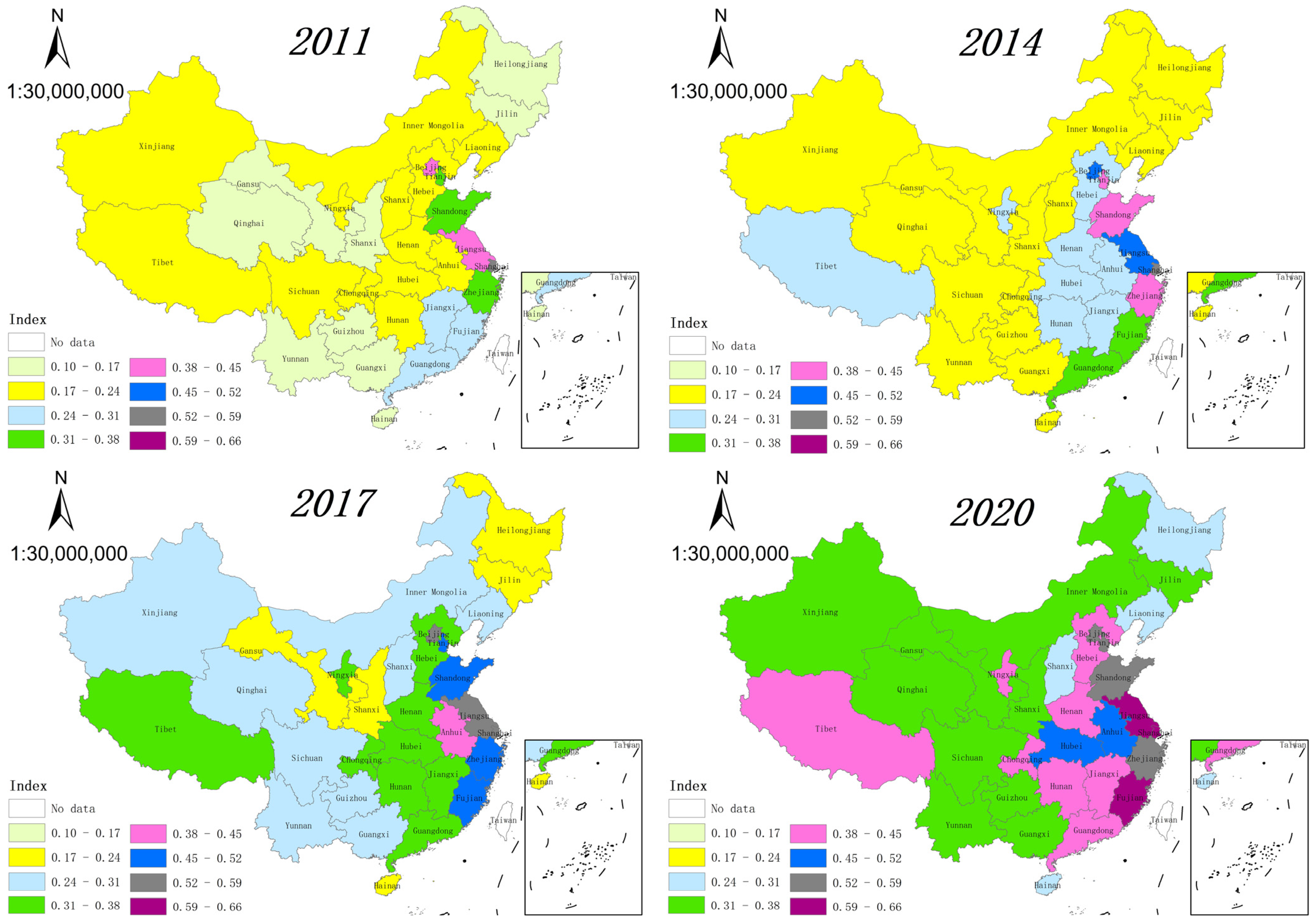
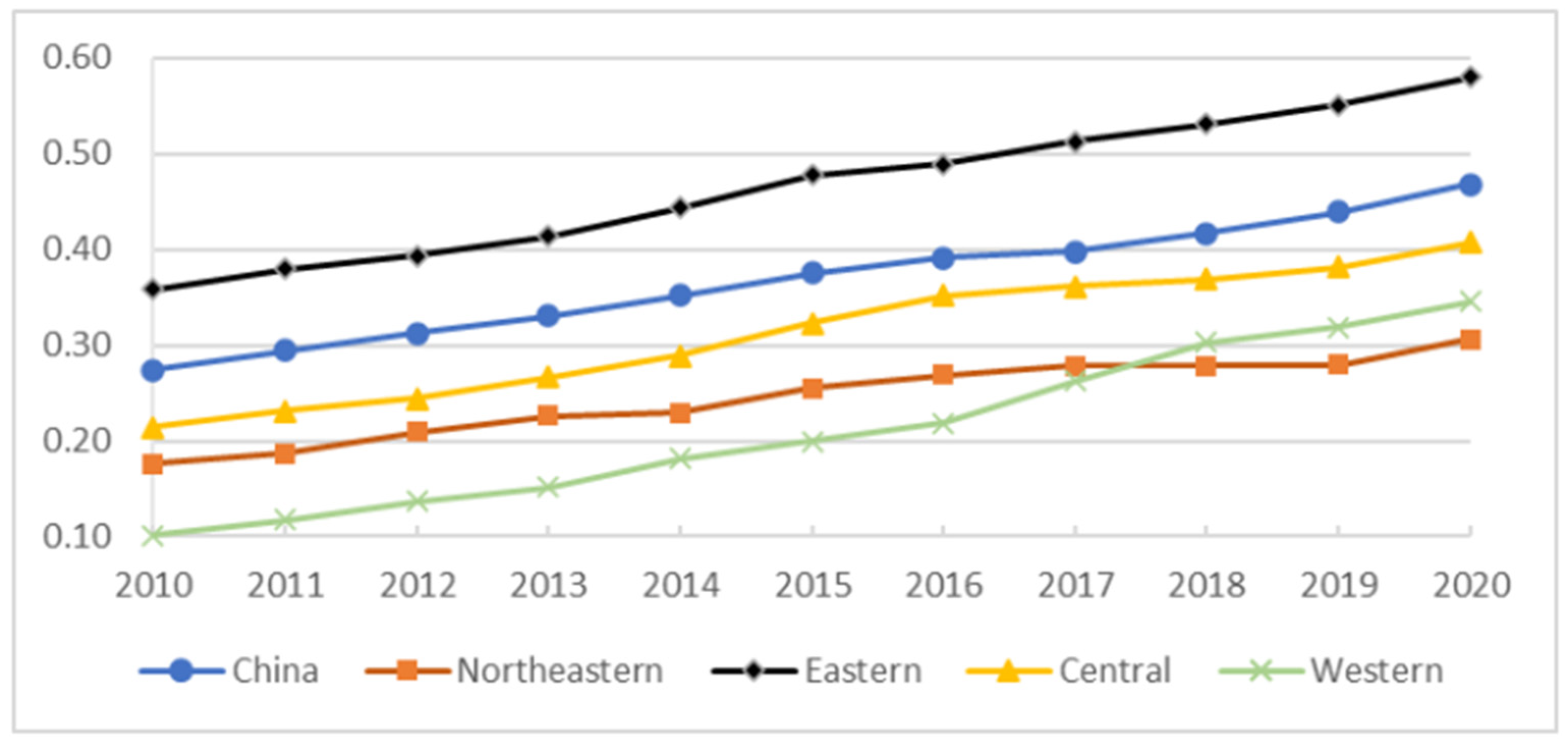

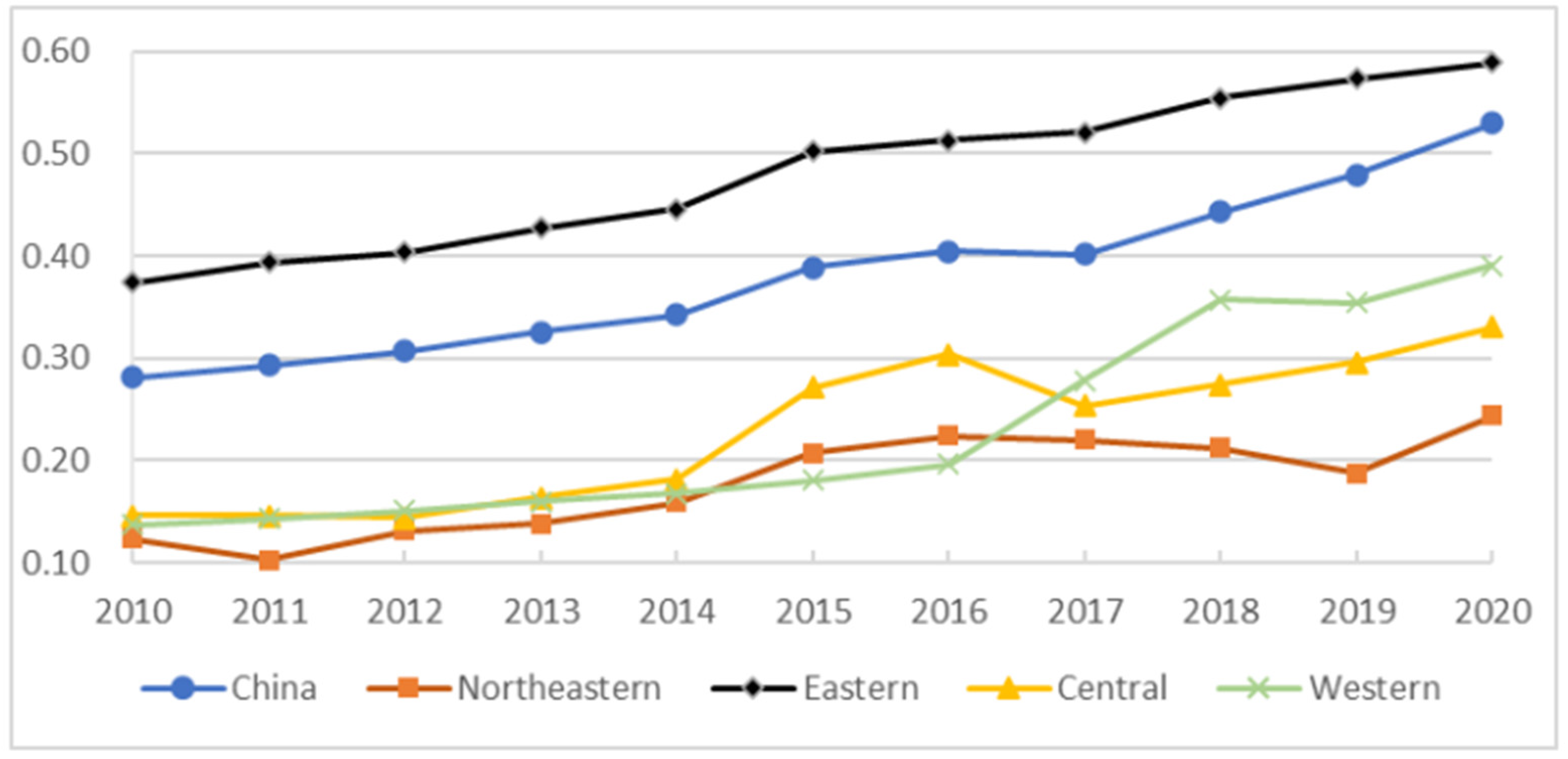

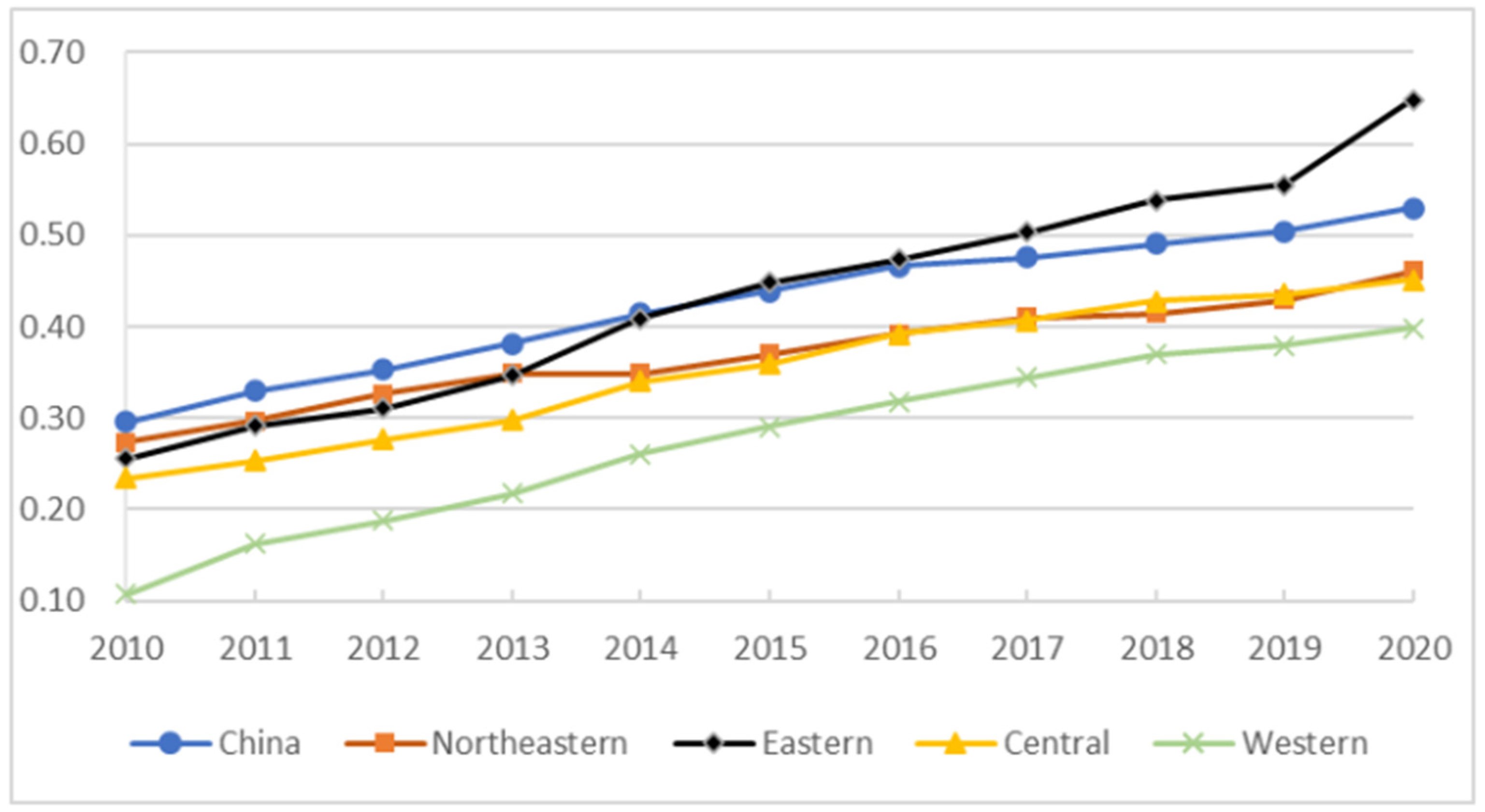

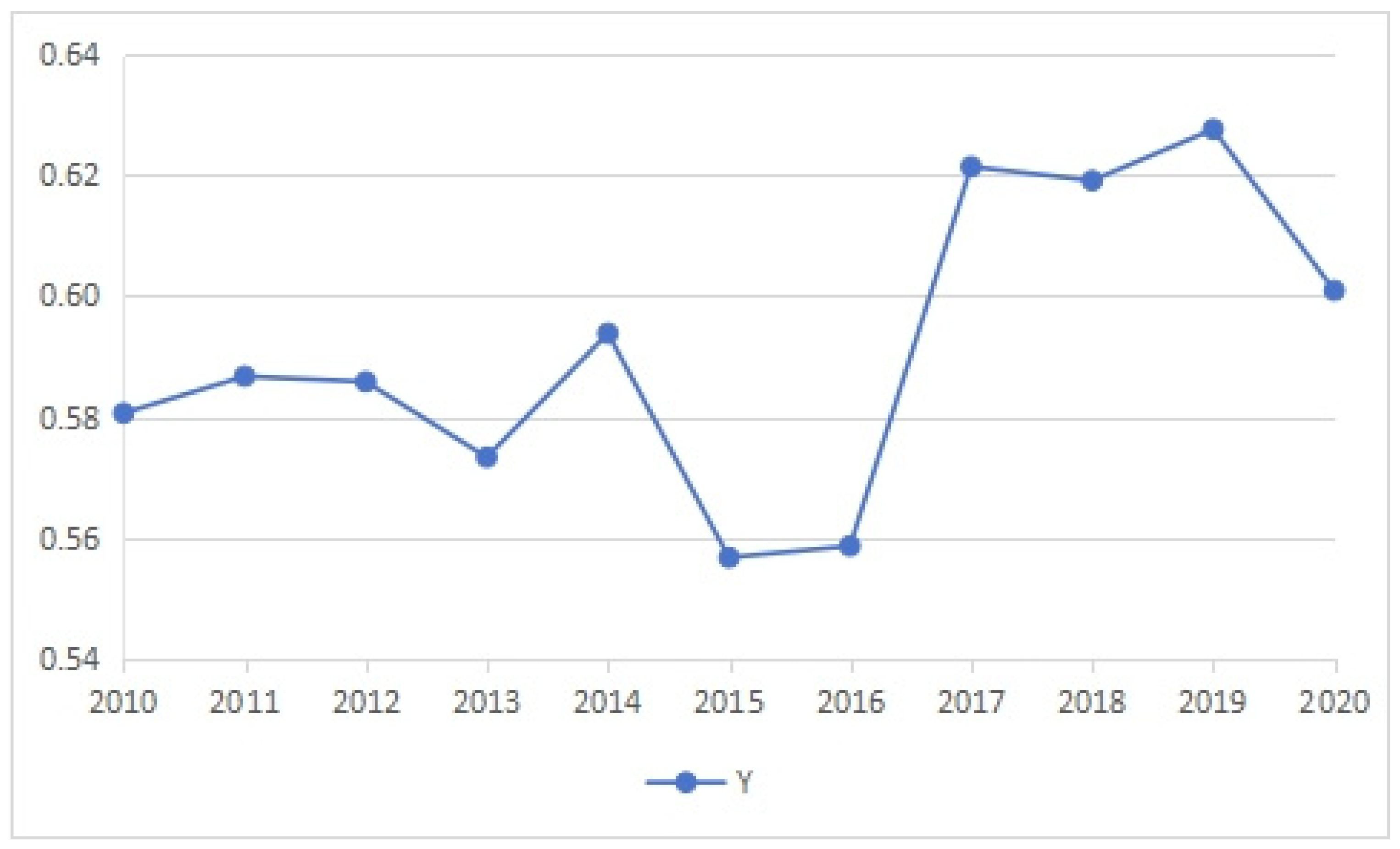

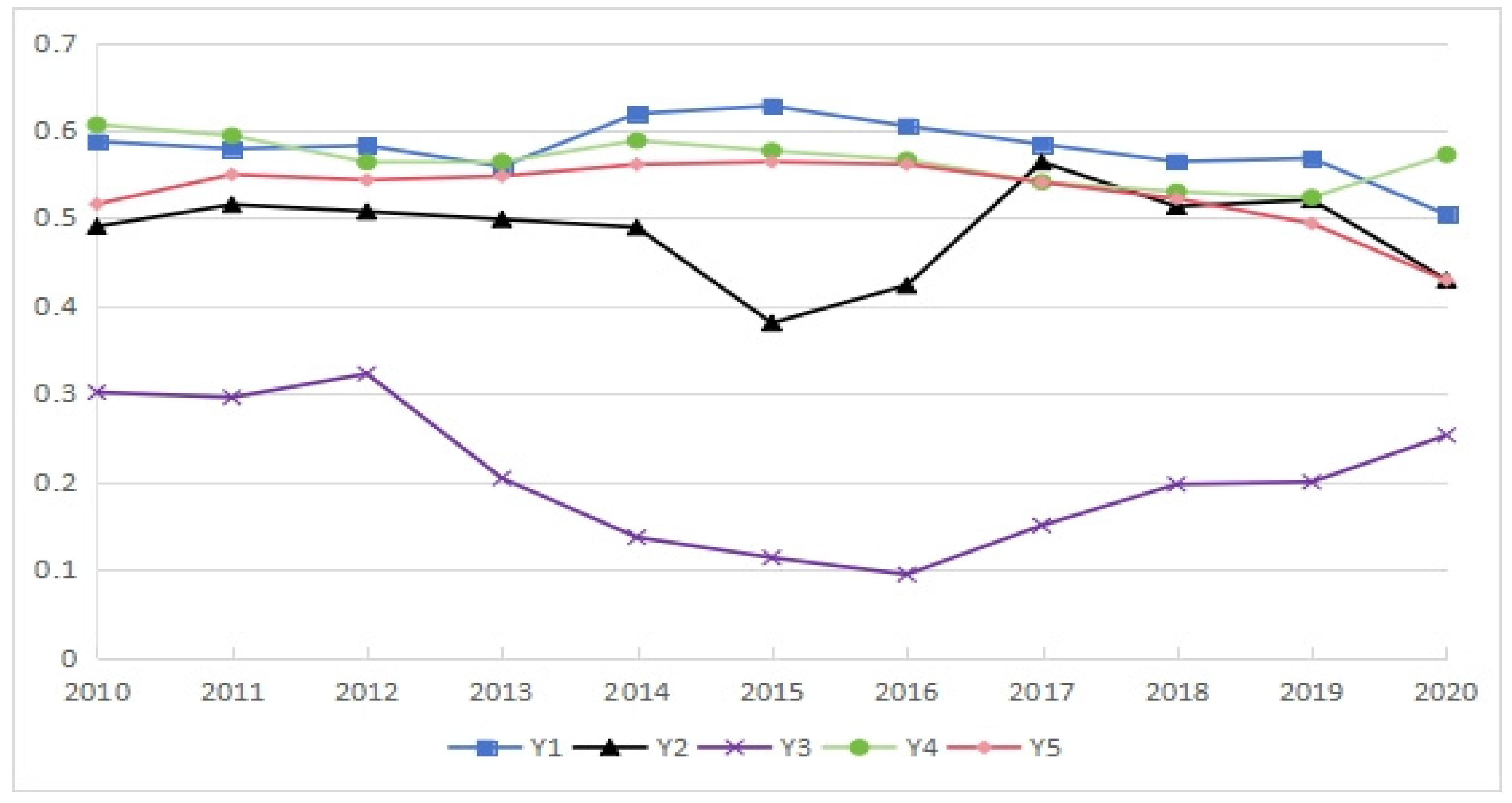

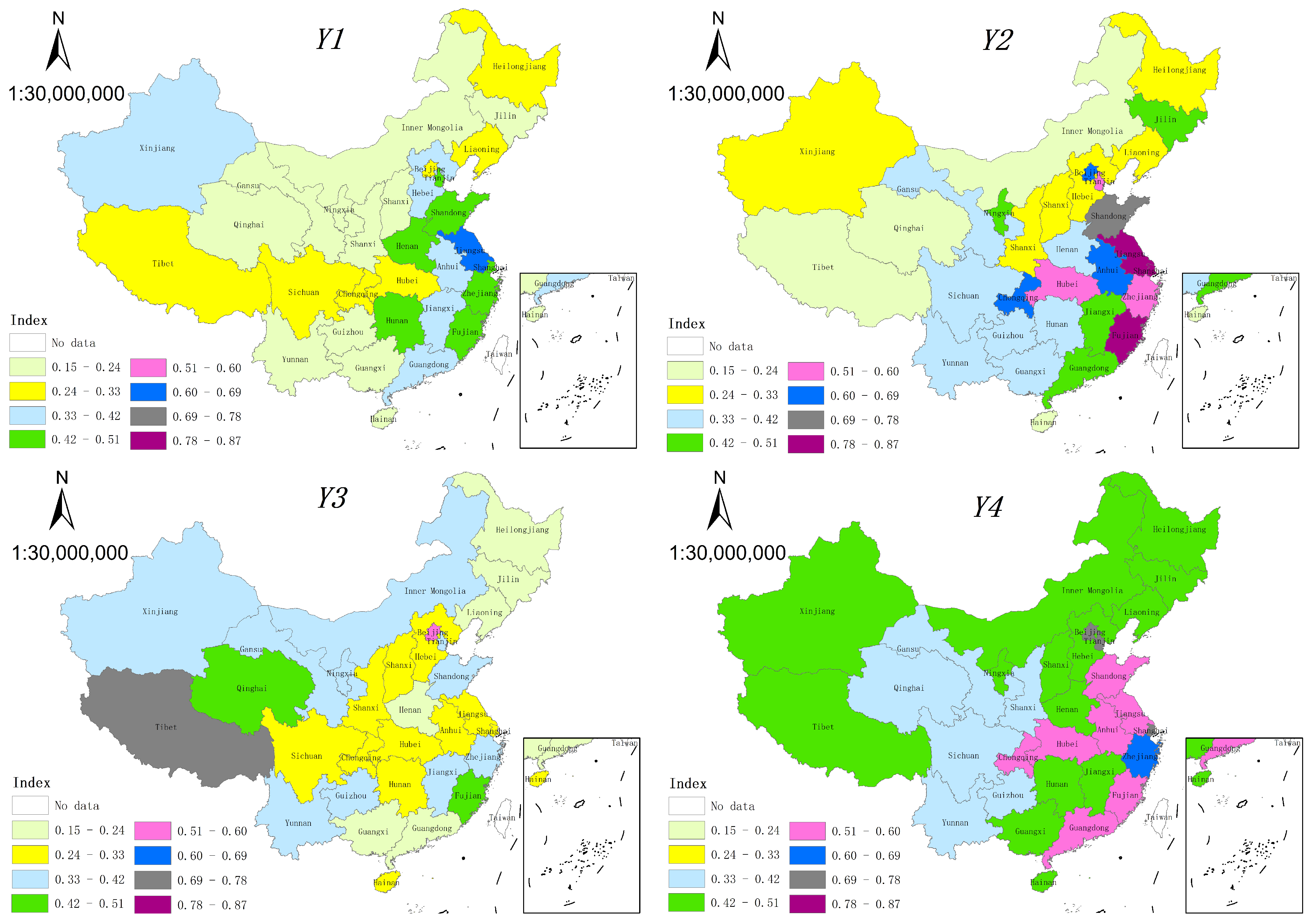
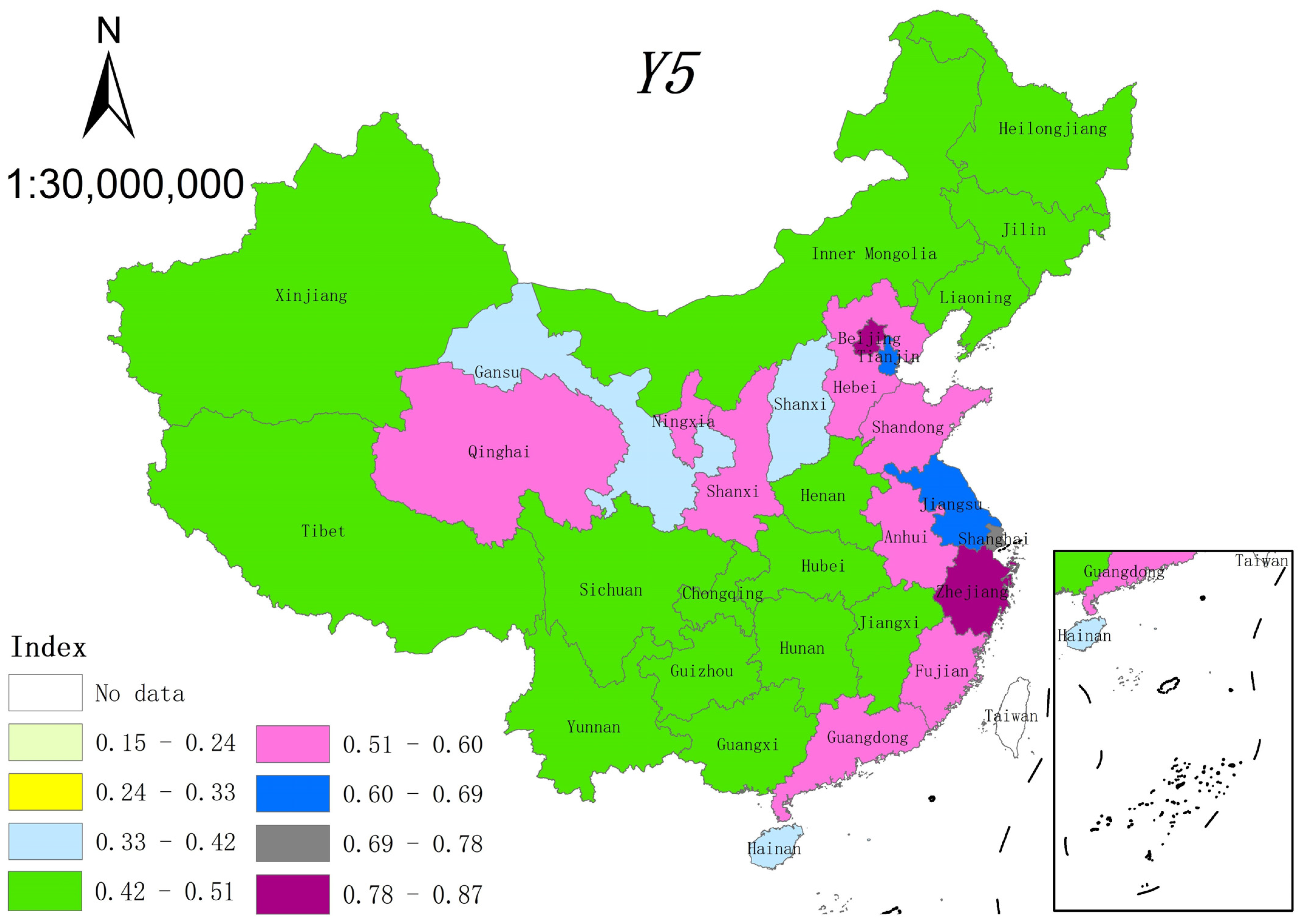
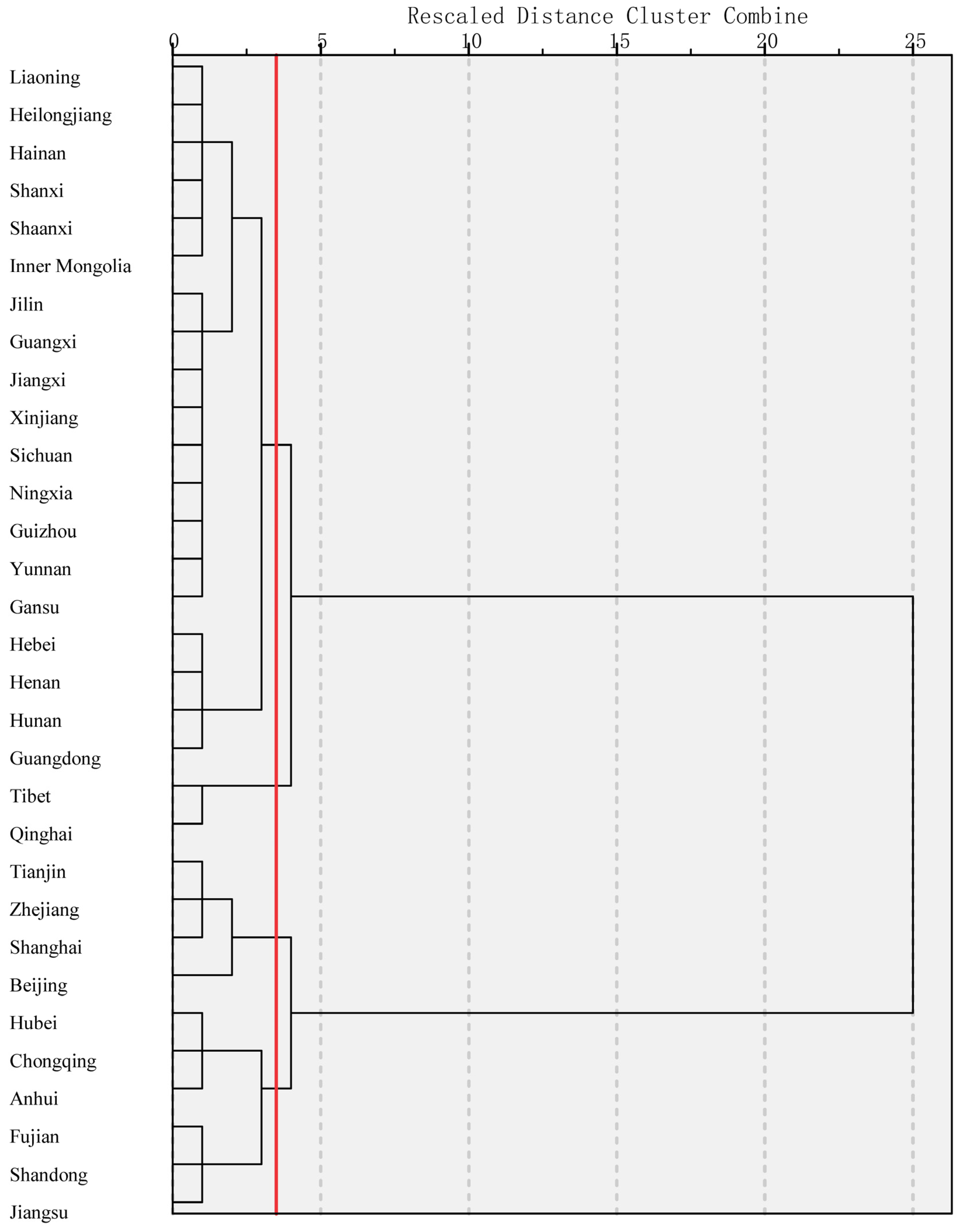
| First-Level Indicator | Second-Level Indicator | Third-Level Indicator | Number | Unit | Attribute | Calculation Method |
|---|---|---|---|---|---|---|
| RR (Y) | Thriving businesses (Y1) | agricultural labor productivity | X1 | yuan/person | + | value of production of agriculture, forestry, animal husbandry, and fishery/village population |
| level of agricultural mechanization | X2 | kW/ha | + | gross power of agricultural machinery/cropland area | ||
| level of irrigation of farmland | X3 | % | + | irrigation farmland area/cropland area | ||
| food crop production per mu | X4 | kg/mu | + | production of food crops/cropland area | ||
| village industrial investment | X5 | m2/person | + | productive buildings area/village population | ||
| share of non-agricultural output | X6 | % | + | value-added of secondary and tertiary industries/village GDP | ||
| Pleasant living environments (Y2) | pesticides application to farmland | X7 | kg/ha | - | quantity of pesticides applied/cropland area | |
| fertilizer application to farmland | X8 | kg/ha | - | quantity of fertilizers applied/cropland area | ||
| village green coverage rate | X9 | % | + | green coverage area/village land area | ||
| hygienic toilet coverage rate | X10 | % | + | village households with hygienic toilets/total village households | ||
| domestic sewage disposal rate | X11 | % | + | sewage disposal volume/total sewage discharge | ||
| non-hazardous disposal rate of domestic waste | X12 | % | + | domestic waste non-hazardous disposal volume/total domestic waste | ||
| Social etiquette and civility (Y3) | village culture and entertainment consumption | X13 | % | + | culture and entertainment consumption/total consumption | |
| village illiteracy rate | X14 | % | - | rural illiterate population above 15/rural population above 15 | ||
| village cultural station | X15 | per person | + | number of village cultural stations/village population | ||
| village social custom | X16 | yuan/person | + | rural cumulative investment in public buildings/village population | ||
| TV program coverage | X17 | % | + | village households with cable TV/village households | ||
| Effective governance (Y4) | proportion of party members among village directors | X18 | % | + | village directors with party membership/village directors | |
| village development planning | X19 | % | + | administrative villages with development planning/administrative villages | ||
| rural poverty incidence | X20 | % | - | village poverty population/village population | ||
| urban–rural income gap | X21 | % | + | rural disposable income per capita/urban disposable income per capita | ||
| medical services level | X22 | % | + | village medics/village population | ||
| minimum subsistence allowance per capita | X23 | yuan/person /year | + | rural minimum subsistence allowance per capita | ||
| Prosperity (Y5) | real income of farmers | X24 | yuan | + | real income of farmers | |
| growth rate of real income of farmers | X25 | % | + | (real income of year—real income of last year)/real income of last year-CPI | ||
| real consumption of farmers | X26 | yuan | + | rural real consumption of farmers | ||
| Engel’s coefficient for rural households | X27 | % | - | rural consumption on food/rural consumption | ||
| number of rural private car | X28 | per household | + | number of private cars/(village households/100) | ||
| rural living area | X29 | m2/person | + | rural living area per capita | ||
| rural tap water coverage | X30 | % | + | village households with tap water/village households | ||
| common prosperity level | X31 | % | + | 1- rural poverty incidence |
| Method | Purpose |
|---|---|
| Entropy weight method | Calculate the RR primary and secondary indexes |
| Spatial correlation analysis | Examine the spatial characteristics of RR indexes |
| Cluster analysis | Cluster the RR secondary indexes for provinces |
| Y | Index1 | Index2 | Index3 | |
|---|---|---|---|---|
| Y | 1 | |||
| index1 | 0.725 *** | 1 | ||
| index2 | 0.679 *** | 0.706 *** | 1 | |
| index3 | 0.726 *** | 0.558 *** | 0.468 *** | 1 |
| Y | DIF | Airpollu | |
|---|---|---|---|
| Y | 1 | ||
| DIF | 0.636 *** | 1 | |
| Airpollu | −0.241 *** | −0.53 *** | 1 |
| Region | Province | RR Index | Ranking | Region | Province | RR Index | Ranking |
|---|---|---|---|---|---|---|---|
| Eastern | Jiangsu | 0.6444 | 1 | Western | Chongqing | 0.4435 | 10 |
| Shanghai | 0.6379 | 2 | Ningxia | 0.3895 | 16 | ||
| Fujian | 0.6038 | 3 | Tibet | 0.3868 | 17 | ||
| Beijing | 0.5856 | 4 | Xinjiang | 0.3743 | 18 | ||
| Zhejiang | 0.5801 | 5 | Sichuan | 0.3636 | 19 | ||
| Shandong | 0.5754 | 6 | Yunnan | 0.3606 | 20 | ||
| Tianjin | 0.5414 | 7 | Guizhou | 0.3452 | 22 | ||
| Guangdong | 0.4229 | 11 | Qinghai | 0.3403 | 23 | ||
| Hebei | 0.4008 | 14 | Gansu | 0.3357 | 24 | ||
| Hainan | 0.2712 | 31 | Inner Mongolia | 0.3293 | 25 | ||
| Central | Anhui | 0.4992 | 8 | Guangxi | 0.3249 | 26 | |
| Hubei | 0.455 | 9 | Shaanxi | 0.3198 | 27 | ||
| Jiangxi | 0.4165 | 12 | Northeastern | Jilin | 0.3506 | 21 | |
| Hunan | 0.4074 | 13 | Liaoning | 0.3066 | 28 | ||
| Henan | 0.3971 | 15 | Heilongjiang | 0.3032 | 29 | ||
| Shanxi | 0.3018 | 30 | China | — | 0.4677 | — |
| Y | RGDP | |
|---|---|---|
| Y | 1 | |
| RGDP | 0.532 *** | 1 |
| Region | Y | Y1 | Y2 | Y3 | Y4 | Y5 |
|---|---|---|---|---|---|---|
| Northeastern | 5 | 4 | 5 | 5 | 3 | 5 |
| Eastern | 1 | 2 | 1 | 1 | 1 | 1 |
| Central | 3 | 1 | 4 | 3 | 4 | 3 |
| Western | 4 | 5 | 3 | 2 | 5 | 4 |
| China | 2 | 3 | 2 | 4 | 2 | 2 |
| Secondary Index | Y1 | Y2 | Y3 | Y4 | Y5 |
|---|---|---|---|---|---|
| Contribution | 20.70% | 26.37% | 12.23% | 15.91% | 24.78% |
| Year | I | E(I) | sd(I) | z | p-Value |
|---|---|---|---|---|---|
| 2010 | 0.581 | −0.033 | 0.115 | 5.351 | 0.00 *** |
| 2011 | 0.587 | −0.033 | 0.115 | 5.370 | 0.00 *** |
| 2012 | 0.586 | −0.033 | 0.116 | 5.342 | 0.00 *** |
| 2013 | 0.573 | −0.033 | 0.117 | 5.204 | 0.00 *** |
| 2014 | 0.594 | −0.033 | 0.117 | 5.349 | 0.00 *** |
| 2015 | 0.557 | −0.033 | 0.118 | 4.987 | 0.00 *** |
| 2016 | 0.559 | −0.033 | 0.118 | 5.003 | 0.00 *** |
| 2017 | 0.621 | −0.033 | 0.119 | 5.511 | 0.00 *** |
| 2018 | 0.619 | −0.033 | 0.119 | 5.464 | 0.00 *** |
| 2019 | 0.628 | −0.033 | 0.120 | 5.529 | 0.00 *** |
| 2020 | 0.601 | −0.033 | 0.120 | 5.306 | 0.00 *** |
| 2013–2016 | 2017–2020 | 2017–2020/2013–2016 | 2017–2020/2013–2016 | |||||
|---|---|---|---|---|---|---|---|---|
| Mean | Std. Dev. | Mean | Std. Dev. | Difference in Mean | p-Value | Difference in Std. Dev. | p-Value | |
| Y1 | 0.279 | 0.133 | 0.296 | 0.126 | 0.017 (5.99%) | 0.155 | −0.007 (−5.42%) | 0.269 |
| Y2 | 0.263 | 0.169 | 0.373 | 0.199 | 0.110 (41.59%) | 0.000 *** | 0.030 (17.93%) | 0.034 ** |
| Y3 | 0.226 | 0.085 | 0.310 | 0.107 | 0.084 (37.20%) | 0.000 *** | 0.022 (26.13%) | 0.005 *** |
| Y4 | 0.373 | 0.089 | 0.469 | 0.096 | 0.096 (25.61%) | 0.000 *** | 0.007 (8.01%) | 0.197 |
| Y5 | 0.368 | 0.126 | 0.498 | 0.124 | 0.129 (35.10%) | 0.000 *** | −0.002 (−1.60%) | 0.429 |
| Y | 0.296 | 0.108 | 0.379 | 0.113 | 0.084 (28.25%) | 0.000 *** | 0.005 (4.13%) | 0.327 |
| Y1 | Y2 | Y3 | Y4 | Y5 | |
|---|---|---|---|---|---|
| Y1 | 1 | ||||
| Y2 | 0.696 *** | 1 | |||
| Y3 | 0.064 | 0.266 *** | 1 | ||
| Y4 | 0.601 *** | 0.722 *** | 0.467 *** | 1 | |
| Y5 | 0.588 *** | 0.736 *** | 0.590 *** | 0.885 *** | 1 |
| Category | Subcategory | Province | Region | Ranking | Category | Subcategory | Province | Region | Ranking |
|---|---|---|---|---|---|---|---|---|---|
| First | 1 | Beijing | Eastern | 4 | Fourth | 6 | Gansu | Western | 24 |
| Shanghai | Eastern | 2 | Yunnan | Western | 20 | ||||
| Zhejiang | Eastern | 5 | Guizhou | Western | 22 | ||||
| Tianjin | Eastern | 7 | Ningxia | Western | 16 | ||||
| Second | 2 | Jiangsu | Eastern | 1 | Sichuan | Western | 19 | ||
| Shandong | Eastern | 6 | Xinjiang | Western | 18 | ||||
| Fujian | Eastern | 3 | Jiangxi | Central | 12 | ||||
| 3 | Anhui | Central | 8 | Guangxi | Western | 26 | |||
| Chongqing | Western | 10 | Jilin | Northeastern | 21 | ||||
| Hubei | Central | 9 | 7 | InnerMongolia | Western | 25 | |||
| Third | 4 | Qinghai | Western | 23 | Shaanxi | Western | 27 | ||
| Tibet | Western | 17 | Shanxi | Central | 30 | ||||
| Fourth | 5 | Guangdong | Eastern | 11 | Hainan | Eastern | 31 | ||
| Hunan | Central | 13 | Heilongjiang | Northeastern | 29 | ||||
| Henan | Central | 15 | Liaoning | Northeastern | 28 | ||||
| Hebei | Eastern | 14 | - | - | - |
| Province | Y1 | Y2 | Y3 | Y4 | Y5 | Y |
|---|---|---|---|---|---|---|
| Beijing | 17 | 7 | 2 | 2 | 1 | 4 |
| Shanghai | 4 | 3 | 17 | 1 | 3 | 2 |
| Zhejiang | 6 | 9 | 5 | 4 | 2 | 5 |
| Tianjin | 7 | 10 | 10 | 3 | 4 | 7 |
| Province | Y1 | Y2 | Y3 | Y4 | Y5 | Y |
|---|---|---|---|---|---|---|
| Jiangsu | 1 | 1 | 18 | 5 | 5 | 1 |
| Shandong | 3 | 4 | 8 | 8 | 6 | 6 |
| Fujian | 2 | 2 | 4 | 6 | 10 | 3 |
| Anhui | 10 | 5 | 21 | 7 | 12 | 8 |
| Chongqing | 19 | 6 | 23 | 11 | 19 | 10 |
| Hubei | 14 | 8 | 22 | 10 | 15 | 9 |
| Province | Y1 | Y2 | Y3 | Y4 | Y5 | Y |
|---|---|---|---|---|---|---|
| Qinghai | 29 | 29 | 3 | 26 | 7 | 23 |
| Tibet | 15 | 30 | 1 | 16 | 14 | 17 |
| Province | Y1 | Y2 | Y3 | Y4 | Y5 | Y |
|---|---|---|---|---|---|---|
| Guangdong | 12 | 12 | 27 | 9 | 9 | 11 |
| Hunan | 5 | 21 | 15 | 21 | 22 | 13 |
| Henan | 8 | 20 | 29 | 12 | 21 | 15 |
| Hebei | 9 | 22 | 24 | 13 | 8 | 14 |
| Gansu | 30 | 15 | 12 | 28 | 30 | 24 |
| Yunnan | 25 | 18 | 6 | 27 | 16 | 20 |
| Guizhou | 31 | 16 | 9 | 30 | 23 | 22 |
| Ningxia | 22 | 13 | 13 | 22 | 11 | 16 |
| Sichuan | 16 | 17 | 20 | 29 | 17 | 19 |
| Xinjiang | 13 | 23 | 7 | 23 | 24 | 18 |
| Jiangxi | 11 | 14 | 11 | 15 | 20 | 12 |
| Guangxi | 24 | 19 | 28 | 18 | 27 | 26 |
| Jilin | 28 | 11 | 30 | 24 | 25 | 21 |
| InnerMongolia | 21 | 28 | 14 | 14 | 18 | 25 |
| Shaanxi | 26 | 24 | 19 | 31 | 13 | 27 |
| Shanxi | 27 | 25 | 16 | 25 | 29 | 30 |
| Hainan | 23 | 31 | 25 | 17 | 31 | 31 |
| Heilongjiang | 18 | 26 | 31 | 20 | 28 | 29 |
| Liaoning | 20 | 27 | 26 | 19 | 26 | 28 |
Disclaimer/Publisher’s Note: The statements, opinions and data contained in all publications are solely those of the individual author(s) and contributor(s) and not of MDPI and/or the editor(s). MDPI and/or the editor(s) disclaim responsibility for any injury to people or property resulting from any ideas, methods, instructions or products referred to in the content. |
© 2024 by the authors. Licensee MDPI, Basel, Switzerland. This article is an open access article distributed under the terms and conditions of the Creative Commons Attribution (CC BY) license (https://creativecommons.org/licenses/by/4.0/).
Share and Cite
Qu, X.; Zhang, Y.; Li, Z. Is China’s Rural Revitalization Good Enough? Evidence from Spatial Agglomeration and Cluster Analysis. Sustainability 2024, 16, 4574. https://doi.org/10.3390/su16114574
Qu X, Zhang Y, Li Z. Is China’s Rural Revitalization Good Enough? Evidence from Spatial Agglomeration and Cluster Analysis. Sustainability. 2024; 16(11):4574. https://doi.org/10.3390/su16114574
Chicago/Turabian StyleQu, Xiaodong, Yuxi Zhang, and Zhenming Li. 2024. "Is China’s Rural Revitalization Good Enough? Evidence from Spatial Agglomeration and Cluster Analysis" Sustainability 16, no. 11: 4574. https://doi.org/10.3390/su16114574





